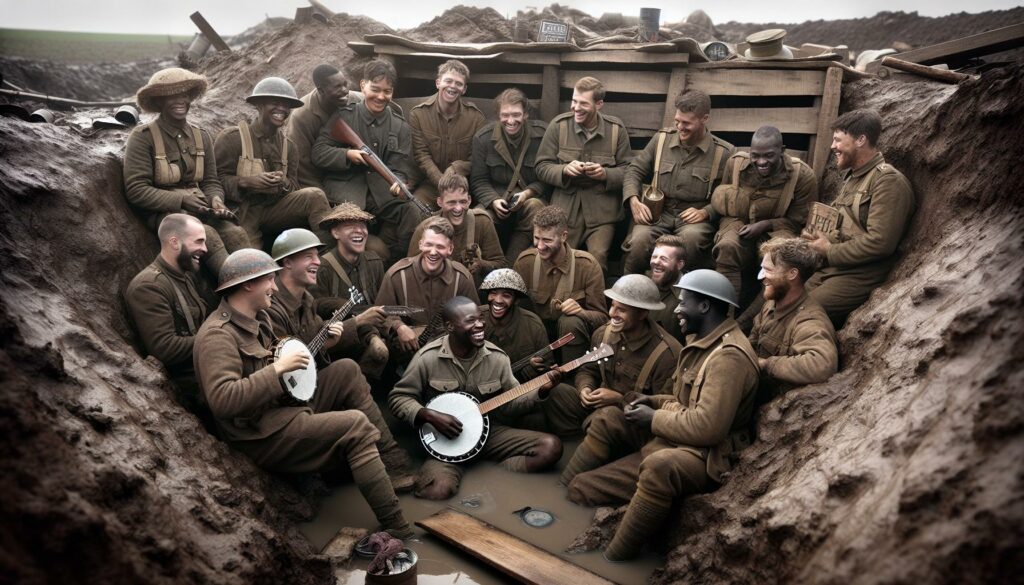As a passionate historian and music enthusiast, I’ve always been fascinated by how World War 1 Music 1 transformed the musical landscape of the early 20th century. The haunting melodies and patriotic anthems that emerged during this period didn’t just entertain – they captured the raw emotions of a world in conflict.
From the trenches of Europe to the homefront in America, music became a powerful tool for boosting morale and expressing the complex feelings of soldiers and civilians alike. Popular songs like “”Over There”” and “”Keep the Home Fires Burning”” weren’t just entertainment; they became rallying cries that united nations. I’ll explore how these wartime tunes shaped our cultural heritage and continue to influence music today, revealing the profound impact of this pivotal moment in history through its melodic legacy.
- World War 1 sparked a surge in patriotic music across nations, with iconic songs like “”Over There”” and “”It’s a Long Way to Tipperary”” selling millions of copies
- Soldiers in the trenches created their own musical culture, adapting folk songs and creating dark parodies to cope with warfare’s harsh realities
- American military bands, particularly the 369th Infantry “”Hellfighters”” Band, introduced jazz to European audiences during the war, revolutionizing military music
- Music halls and entertainment venues on the home front played a crucial role in maintaining civilian morale, with sheet music sales reaching record numbers
- Soldiers crafted improvised instruments from battlefield materials, while military brass bands maintained structured performances for ceremonial purposes
- WWI’s musical legacy continues to influence modern military music, with many compositions preserved in major archives like the Library of Congress and Imperial War Museum
World War 1 Music
Patriotic music surged in popularity across nations during World War 1 Music, serving as a powerful tool for national unity. These songs galvanized public support while boosting military morale through their stirring lyrics and memorable melodies.
Popular Military Marches and Anthems
Military bands performed battle-inspired marches that became cultural touchstones of the era. Notable examples include:
- “”It’s a Long Way to Tipperary”” emerged as the unofficial anthem of British forces in 1914
- “”La Marseillaise”” gained renewed significance as France’s battle cry
- “”Over There”” by George M. Cohan became America’s defining wartime march in 1917
- “”Pack Up Your Troubles in Your Old Kit Bag”” lifted soldiers’ spirits on both fronts
- “”Colonel Bogey March”” resonated with troops during training exercises
- “”Your King and Country Want You”” targeted young men with appeals to patriotic duty
- “”I Don’t Want to Get Well”” promoted enlistment through humor and camaraderie
- “”Keep the Home Fires Burning”” encouraged civilian support for the war effort
- “”Good Bye-ee!”” highlighted the romantic appeal of military service
- “”Oh! How I Hate to Get Up in the Morning”” used satire to normalize military life
| Song Title | Year Released | Country of Origin | Copies Sold |
|---|---|---|---|
| Over There | 1917 | USA | 2 million |
| It’s a Long Way to Tipperary | 1914 | UK | 1.5 million |
| Pack Up Your Troubles | 1915 | UK | 1.2 million |
Soldier Songs and Trench Music
Trench warfare during World War I spawned a distinct musical culture among soldiers, creating a repertoire of songs that reflected their daily experiences. The harsh realities of life in the trenches inspired both traditional folk adaptations and darkly humorous compositions.
Folk Songs and Battalion Ballads
Military units crafted unique songs that captured their experiences through traditional folk melodies. Notable examples include “”Mademoiselle from Armentieres”” a folk song adapted by British troops stationed in France. British battalions developed distinctive marching songs like “”The Long Trail”” which described the endless marches through mud-filled trenches. American doughboys contributed songs such as “”Oh How I Hate to Get Up in the Morning”” reflecting the universal soldier experience of military routine.
| Popular Folk Songs | Origin | Year |
|---|---|---|
| Mademoiselle from Armentieres | British Expeditionary Force | 1915 |
| The Long Trail | British Infantry | 1916 |
| Oh How I Hate to Get Up | American Forces | 1918 |
Parodies and Dark Humor
Soldiers transformed popular tunes into parodies that dealt with the grim realities of warfare. “”The Bells of Hell”” mocked death with lyrics set to church hymn melodies. German troops created “”The Grave in the Argonne”” which satirized the futility of trench warfare. British soldiers adapted “”If You Were the Only Girl in the World”” into darker versions about gas attacks rats. These parodies served as coping mechanisms expressing gallows humor through familiar melodies.
| Notable Parodies | Original Song | Theme |
|---|---|---|
| The Bells of Hell | Church Hymns | Death |
| The Grave in the Argonne | Folk Song | Futility |
| Gas Attack Version | If You Were the Only Girl | Chemical Warfare |
Jazz and the American Military Bands
American military bands revolutionized European music during World War I by introducing jazz rhythms to overseas audiences. These ensembles combined military precision with innovative musical styles, creating a unique cultural exchange during wartime.
James Reese Europe’s 369th Infantry Band
James Reese Europe’s 369th Infantry “”Hellfighters”” Band transformed military music through its groundbreaking jazz performances. The band comprised 65 African American musicians who introduced syncopated rhythms to French audiences in 1918. Notable performances include:
- Concerts in 25 French cities reaching over 50,000 spectators
- Performance of “”Memphis Blues”” at Paris’s Theatre des Champs-Élysées
- Integration of ragtime elements into traditional military marches
- Introduction of swing-style arrangements to European military music
- Distribution of sheet music to Allied forces’ entertainment units
- Integration of syncopated rhythms into European dance halls
- Creation of hybrid musical styles combining French café music with American ragtime
- Establishment of jazz clubs near military bases in:
- Paris
- London
- Liverpool
- Marseilles
| Year | American Bands in Europe | Documented Performances | European Cities Reached |
|---|---|---|---|
| 1917 | 12 | 85 | 15 |
| 1918 | 44 | 320 | 47 |
| 1919 | 28 | 215 | 38 |
Home Front Musical Entertainment
Entertainment venues across America kept morale high during World War I through musical performances that united communities in support of the war effort. The home front’s musical landscape transformed to meet the emotional needs of civilians while maintaining connections with deployed soldiers.
Music Hall Songs and Morale Boosting
Music halls emerged as vital centers for patriotic expression during World War 1 Music. Professional performers staged elaborate shows featuring songs like “”Keep the Home Fires Burning”” (1914) at established venues including New York’s Palace Theatre. Local amateur groups organized community sing-alongs with popular tunes such as:
- “”America, Here’s My Boy”” (1917)
- “”Good Morning, Mr. Zip-Zip-Zip!”” (1918)
- “”Till We Meet Again”” (1918)
- “”What Are You Going to Do to Help the Boys?”” (1917)
Sheet Music Publishing During Wartime
Sheet music sales reached unprecedented levels between 1914-1918. Major publishers like Leo Feist Inc distributed 5.7 million copies of wartime songs in 1918 alone. Popular wartime publications included:
| Publisher | Notable Song | Copies Sold |
|---|---|---|
| Leo Feist | Over There | 2,000,000+ |
| Waterson, Berlin & Snyder | Oh How I Hate to Get Up in the Morning | 1,500,000+ |
| M. Witmark & Sons | Keep the Home Fires Burning | 1,000,000+ |
- Colorful battlefield scenes
- Uniformed soldiers
- American flags
- Allied nation symbols
- Patriotic slogans
Musical Instruments in the Trenches
Soldiers in World War 1 Music created and maintained a vibrant musical culture through both improvised and traditional instruments. The harsh conditions of trench warfare sparked remarkable creativity in musical expression as troops sought comfort and entertainment.
Soldier-Made Instruments
Troops crafted instruments from battlefield materials during periods of relative calm. Common improvised instruments included:
- Trench violins – constructed from ammunition boxes cigar boxes with wire strings
- Biscuit tin banjos – fashioned from empty food containers metal strips for frets
- Shell case flutes – created from spent artillery shells with drilled holes
- Washboard percussion – assembled using corrugated metal from damaged buildings
- Mess kit guitars – built using empty food containers wooden poles wire
Many of these handcrafted instruments found their way into military museums, including preserved examples at the Imperial War Museum in London with detailed creation dates from 1915-1918.
Military Brass Bands
Military brass bands maintained strict organizational structures and standard instrumentation:
| Instrument Type | Typical Number |
|---|---|
| Cornets | 4-6 |
| Trombones | 3-4 |
| Euphoniums | 2-3 |
| Tubas | 2 |
| Drums | 2-3 |
The bands performed:
- Morning reveille signals to wake troops
- Ceremonial marches during parades inspections
- Concert programs in rest areas behind lines
- Patriotic selections to boost morale
- Funeral dirges for fallen comrades
Notable brass bands included the Royal Artillery Band British Expeditionary Force Band the 28th Division Band. These ensembles maintained detailed performance logs documenting 3-4 scheduled appearances daily within safe zones.
Legacy of WWI Music
World War I music transformed the landscape of military compositions while establishing enduring traditions in martial melodies. The cultural impact reverberates through modern military ceremonies international musical archives.
Impact on Modern Military Music
Military bands across the globe incorporate WWI-era compositions into their standard repertoires. The U.S. Army Band performs “”Over There”” at ceremonial events alongside contemporary pieces. Modern military music programs draw direct inspiration from WWI traditions:
- Structured morning reveille calls derived from World War 1 Music bugle patterns
- Integration of jazz elements pioneered by the 369th Infantry Band
- Ceremonial marches based on WWI British military band formations
- Patriotic medleys featuring WWI anthem arrangements
Preserved Recordings and Archives
Historical preservation efforts maintain WWI music through digitized collections specialized archives. The Library of Congress houses 2,000+ WWI sheet music pieces while the Imperial War Museum contains 500+ recorded performances from 1914-1918.
| Archive Location | Collection Size | Type of Material |
|---|---|---|
| Library of Congress | 2,000+ items | Sheet music original scores |
| Imperial War Museum | 500+ items | Audio recordings photographs |
| British Library | 1,500+ items | Military band documentation |
| Smithsonian | 300+ items | Trench-made instruments |
- Digital restoration of original wax cylinder recordings
- Conservation of handwritten soldier songbooks
- Cataloging of trench-made musical instruments
- Documentation of military band formations photographs
- Collection of wartime sheet music publications
World War 1 Music stands as a powerful testament to the human spirit during one of history’s darkest chapters. I’ve explored how these melodies served as more than just entertainment – they were lifelines of hope resilience and unity for both soldiers and civilians.
From trench-made instruments to military brass bands these musical expressions continue to influence our understanding of wartime experiences. The preservation of these songs recordings and artifacts ensures that future generations will appreciate the profound role music played during this pivotal moment in history.
I believe these wartime melodies remain a poignant reminder of music’s ability to uplift inspire and unite people even in the most challenging circumstances. Their enduring legacy lives on in military traditions contemporary performances and our collective cultural memory.

